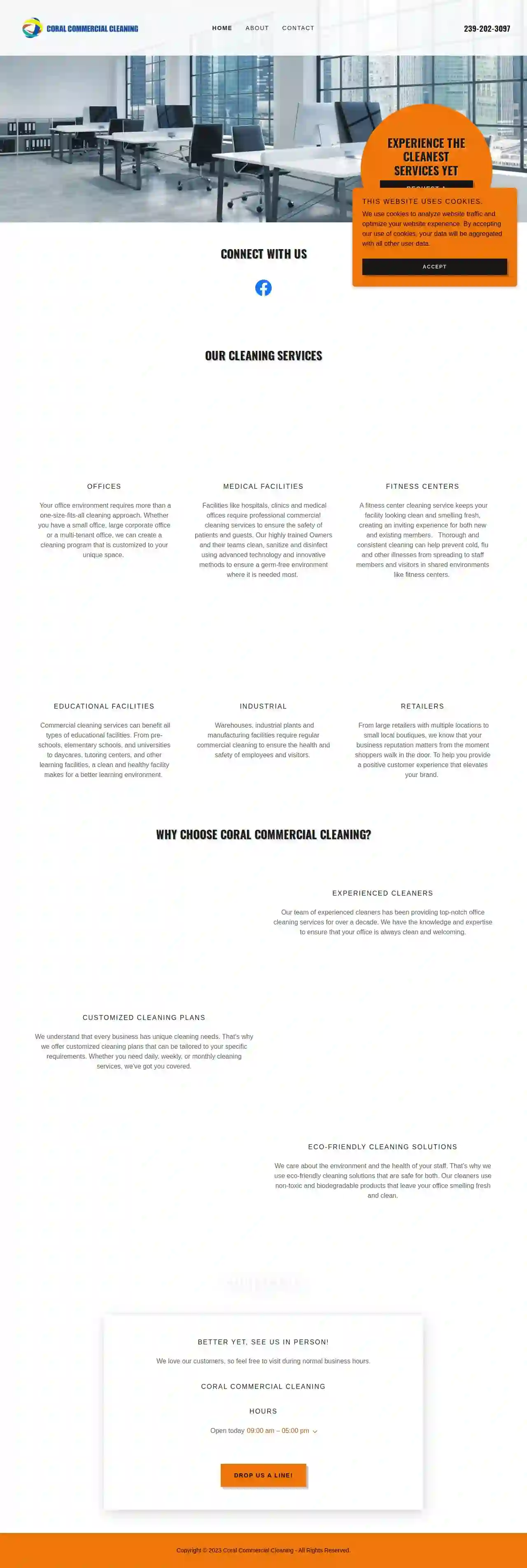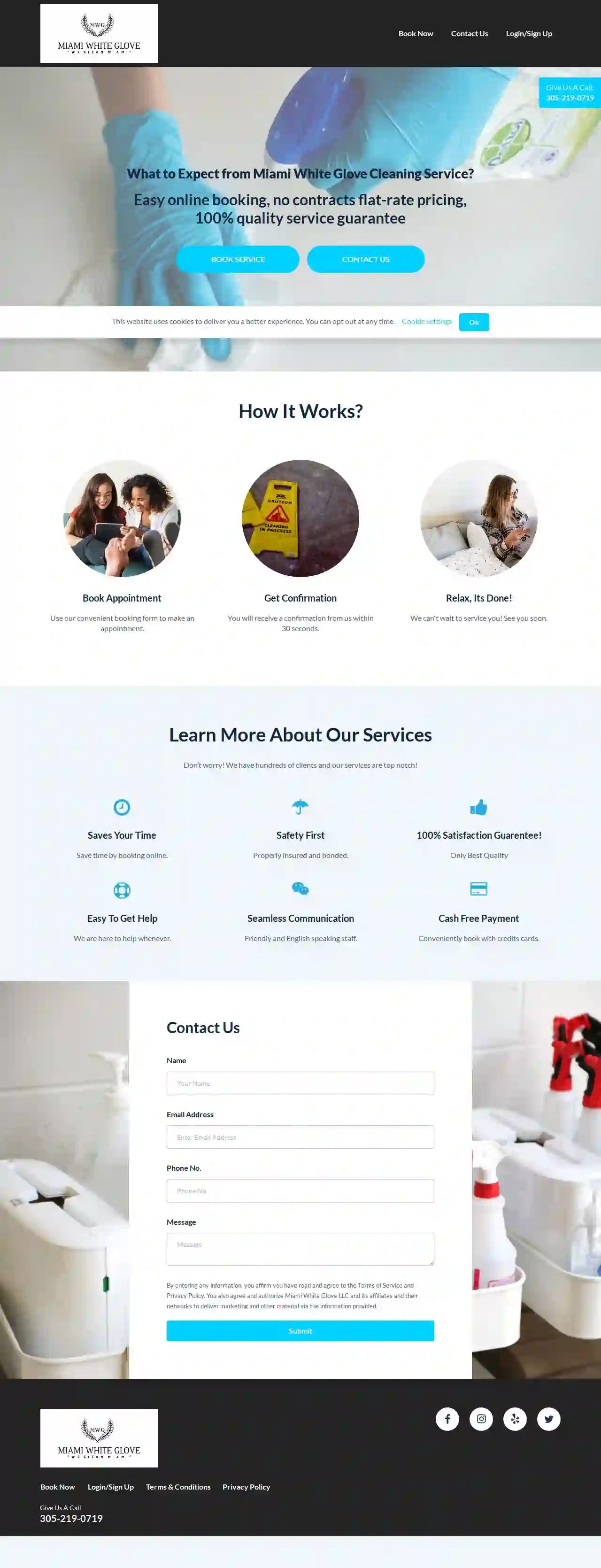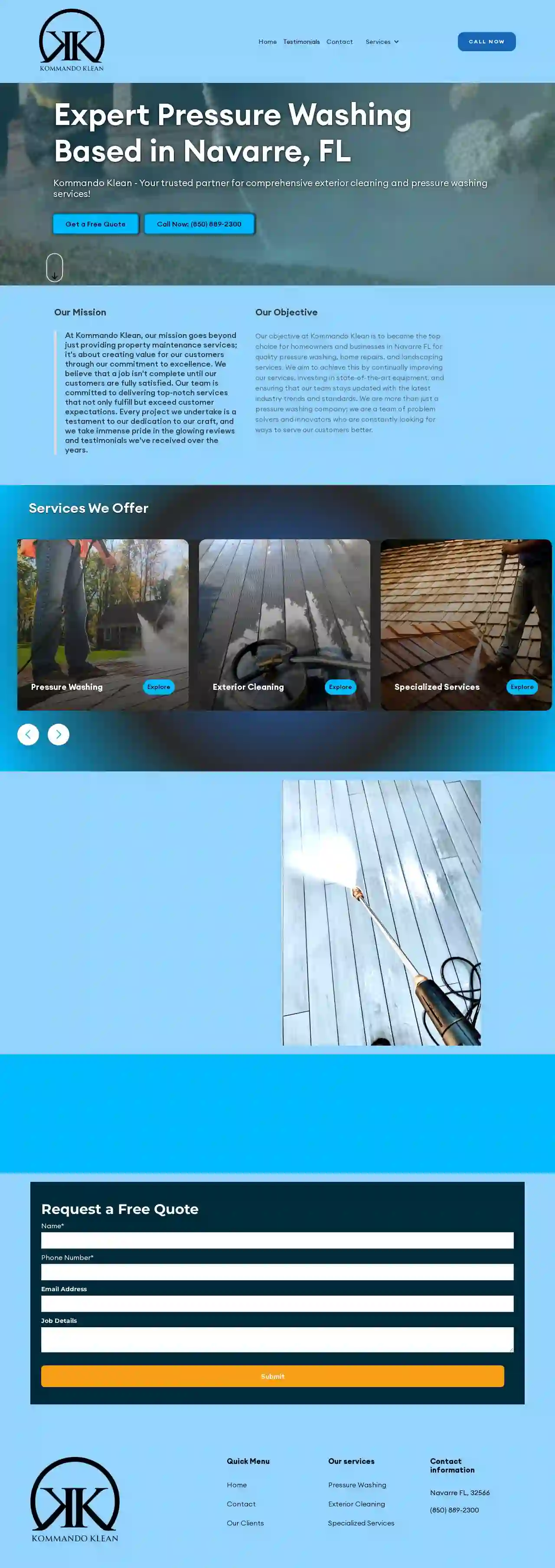Cleaning Services Broadview Park
Top Local Cleaners in Broadview Park
Get up to 3 Cleaning Companies quotes for your project today! Compare profiles, reviews, accreditations, portfolio, etc... and choose the best service.

We Clean SWFL
59 reviews1234 SW Pine Island Rd, Fort Myers, 33901, USWe Clean SWFL is a professional cleaning service specializing in residential and commercial cleaning. Our mission is to provide top-notch cleaning solutions tailored to meet the unique needs of our clients. With a team of experienced professionals, we strive to deliver exceptional service and ensure customer satisfaction. We are fully insured and accredited, ensuring peace of mind for our clients. Our services include one-time, weekly, bi-weekly, and monthly cleaning options, as well as move-in/move-out, construction cleanup, and special event cleaning. We serve various cities in SWFL, including Fort Myers, Cape Coral, and Naples.
- Services
- Why Us?
- Accreditations
- Our Team
- Testimonials
Get Quote
K & C Master Cleaning Inc
512 reviews123 Clean Street, CleanCity, 12345, USK & C Master Cleaning is a professional cleaning service dedicated to providing top-notch cleaning solutions to residential and commercial clients. With a strong commitment to quality, customer satisfaction, and environmental sustainability, the company strives to make every space clean, safe, and healthy. Their team of experienced professionals uses eco-friendly products and state-of-the-art equipment to ensure exceptional results.
- Services
- Why Us?
- Accreditations
- Our Team
- Testimonials
Get Quote
VHR THE CLEANING COMPANY
52 reviews10001, Rockville, 20171, USVHR LLC is a leading provider of comprehensive human resources solutions. With a proven track record of success, we partner with businesses of all sizes to optimize their workforce and achieve their strategic goals. Our team of experienced HR professionals offers a wide range of services, including recruitment, talent management, compensation and benefits, employee relations, and compliance. At VHR LLC, we understand the complexities of today's business environment and the critical role that human capital plays in driving success. We are committed to providing our clients with innovative and customized solutions that meet their unique needs. Our mission is to empower businesses to build high-performing teams, foster a positive work environment, and achieve sustainable growth. We pride ourselves on our integrity, professionalism, and client-centric approach. Our goal is to build long-term relationships with our clients based on trust, transparency, and mutual success.
- Services
- Why Us?
Get Quote
Coral commercial cleaning Corp
53 reviewsCape Coral, US- Services
- Why Us?
- Gallery
Get Quote
Miami White Glove, LLC
51 reviews123 Main St, Miami, 33101, USAt Miami White Glove, we pride ourselves on being the go-to cleaning and organization experts in South Florida. With years of experience in the industry, our team is dedicated to providing top-notch services that cater to the unique needs of each client. From residential cleaning and organization to commercial cleaning and move-in/move-out services, we strive to deliver exceptional results that exceed our clients' expectations. Our mission is to provide a cleaner, healthier, and more organized living and working space for our clients. We achieve this by using eco-friendly products, state-of-the-art equipment, and a team of highly trained professionals who are passionate about what they do.
- Services
- Why Us?
- Accreditations
- Our Team
- Testimonials
Get Quote
Wholy Clean LLC
524 reviewsLos Angeles, USWholy Clean LLC is a thorough cleaning business that caters mostly to businesses all around Los Angeles, California, including but not limited to: event spaces, barbershops, beauty salons, boutiques, and other businesses that require frequent cleaning. We have grown to service homes and will continue to offer our services to both business and residential spaces. Wholy Clean LLC maintains a professional staff that can work efficiently and can complete a job effectively. Wholy Clean LLC values sustainability and uses eco-friendly products that reduce our environmental footprint, all while providing a valuable service that will help keep a space sanitized, sparkling, and sustainable.
- Services
- Why Us?
- Accreditations
- Our Team
- Testimonials
- Gallery
Get Quote
Kommando Klean
53 reviewsNavarre, US- Services
- Why Us?
Get Quote
ITSCLEAN SERVICES BROWARD
513 reviewsMiami, US- Services
- Why Us?
Get Quote- Mi
Mid-Westchester Sewer & Drain Service
514 reviewsWestchester, US- Services
- Why Us?
Get Quote - SW
SW Cleaning Pros
521 reviewsCape Coral, US- Services
- Why Us?
Get Quote
Over 60,241+ Janitorial Contractors in our network
Our janitorial service providers operate in Broadview Park & surrounding areas!
CleaningMatch has curated and vetted the Best Cleaning Services arround Broadview Park. Find a reliable pro today.
Frequently Asked Questions About Cleaning Services
- Clean Pet Bedding: Wash pet bedding regularly in hot water to remove odors and bacteria.
- Vacuum Thoroughly: Vacuum carpets, rugs, and upholstery frequently using a vacuum cleaner with a pet hair attachment.
- Enzyme Cleaners: Use enzyme cleaners specifically designed for pet odors. These cleaners break down the odor-causing molecules.
- Baking Soda: Sprinkle baking soda on carpets and upholstery, let it sit for a few hours, then vacuum. Baking soda absorbs odors.
- Air Fresheners: Use air fresheners or diffusers to mask odors temporarily.
- Professional Cleaning: For persistent odors, consider hiring a professional cleaning service specializing in pet odor removal.
- Regular Sweeping or Dust Mopping: Sweep or dust mop hardwood floors daily to remove dust, dirt, and debris.
- Vacuuming: Vacuum hardwood floors weekly using a vacuum cleaner with a hardwood floor attachment to avoid scratches.
- Damp Mopping: Damp mop hardwood floors with a hardwood floor cleaner as needed. Avoid excessive water, as it can damage the wood.
- Prevent Scratches: Place felt pads under furniture legs to prevent scratches. Avoid dragging heavy objects across the floor.
- Avoid Harsh Cleaners: Do not use harsh chemicals, abrasive cleaners, or furniture polish on hardwood floors.
- Professional Cleaning: Consider hiring a professional hardwood floor cleaning service for deep cleaning and refinishing as needed.
- Frees up your time: Cleaning can be time-consuming, especially for larger properties or busy individuals. Hiring a cleaning service allows you to focus on other priorities, such as work, family, or leisure activities.
- Ensures a deeper clean: Professional cleaners are trained in effective cleaning techniques and have access to specialized equipment, resulting in a more thorough clean than you might achieve on your own.
- Reduces allergens and improves hygiene: Thorough cleaning removes dust, allergens, and germs, creating a healthier living environment, particularly for those with allergies or sensitivities.
- Reduces stress and improves well-being: Coming home to a clean and tidy home can reduce stress and promote a sense of calm and order.
- Blot, don't rub: When treating fresh stains, blot with a clean cloth or paper towel to absorb as much of the stain as possible. Rubbing can spread the stain and damage carpet fibers.
- Club Soda: For spills like wine or coffee, pour club soda on the stain, let it fizz, then blot with a clean cloth. Repeat if needed.
- Vinegar Solution: Mix equal parts white vinegar and water, apply to the stain, and blot. Vinegar helps remove stains and odors.
- Baking Soda Paste: Make a paste with baking soda and water, apply to the stain, let it dry, then vacuum. Baking soda absorbs odors and lifts stains.
- Commercial Carpet Cleaner: : Use a commercial carpet cleaner according to the instructions. Choose a cleaner specifically designed for the type of stain you're dealing with.
- Professional Carpet Cleaning: For stubborn or deeply set stains, consider hiring a professional carpet cleaning service. They have specialized equipment and expertise in stain removal.
How do I get rid of pet odors in my home?
Regular cleaning, enzyme cleaners, and baking soda are effective methods for eliminating pet odors and maintaining a fresh-smelling home.
What are some tips for cleaning hardwood floors?
By following these tips, you can keep your hardwood floors looking beautiful for years to come.
Are cleaning services worth it?
If you value these benefits and find the cost justifiable, cleaning services can be a worthwhile investment in your time and well-being.
How can I get rid of tough stains on carpets?
Always test any cleaning solution on a small, inconspicuous area of the carpet first to ensure it doesn't cause discoloration or damage.
How do I get rid of pet odors in my home?
- Clean Pet Bedding: Wash pet bedding regularly in hot water to remove odors and bacteria.
- Vacuum Thoroughly: Vacuum carpets, rugs, and upholstery frequently using a vacuum cleaner with a pet hair attachment.
- Enzyme Cleaners: Use enzyme cleaners specifically designed for pet odors. These cleaners break down the odor-causing molecules.
- Baking Soda: Sprinkle baking soda on carpets and upholstery, let it sit for a few hours, then vacuum. Baking soda absorbs odors.
- Air Fresheners: Use air fresheners or diffusers to mask odors temporarily.
- Professional Cleaning: For persistent odors, consider hiring a professional cleaning service specializing in pet odor removal.
Regular cleaning, enzyme cleaners, and baking soda are effective methods for eliminating pet odors and maintaining a fresh-smelling home.
What are some tips for cleaning hardwood floors?
- Regular Sweeping or Dust Mopping: Sweep or dust mop hardwood floors daily to remove dust, dirt, and debris.
- Vacuuming: Vacuum hardwood floors weekly using a vacuum cleaner with a hardwood floor attachment to avoid scratches.
- Damp Mopping: Damp mop hardwood floors with a hardwood floor cleaner as needed. Avoid excessive water, as it can damage the wood.
- Prevent Scratches: Place felt pads under furniture legs to prevent scratches. Avoid dragging heavy objects across the floor.
- Avoid Harsh Cleaners: Do not use harsh chemicals, abrasive cleaners, or furniture polish on hardwood floors.
- Professional Cleaning: Consider hiring a professional hardwood floor cleaning service for deep cleaning and refinishing as needed.
By following these tips, you can keep your hardwood floors looking beautiful for years to come.
Are cleaning services worth it?
- Frees up your time: Cleaning can be time-consuming, especially for larger properties or busy individuals. Hiring a cleaning service allows you to focus on other priorities, such as work, family, or leisure activities.
- Ensures a deeper clean: Professional cleaners are trained in effective cleaning techniques and have access to specialized equipment, resulting in a more thorough clean than you might achieve on your own.
- Reduces allergens and improves hygiene: Thorough cleaning removes dust, allergens, and germs, creating a healthier living environment, particularly for those with allergies or sensitivities.
- Reduces stress and improves well-being: Coming home to a clean and tidy home can reduce stress and promote a sense of calm and order.
If you value these benefits and find the cost justifiable, cleaning services can be a worthwhile investment in your time and well-being.
How can I get rid of tough stains on carpets?
- Blot, don't rub: When treating fresh stains, blot with a clean cloth or paper towel to absorb as much of the stain as possible. Rubbing can spread the stain and damage carpet fibers.
- Club Soda: For spills like wine or coffee, pour club soda on the stain, let it fizz, then blot with a clean cloth. Repeat if needed.
- Vinegar Solution: Mix equal parts white vinegar and water, apply to the stain, and blot. Vinegar helps remove stains and odors.
- Baking Soda Paste: Make a paste with baking soda and water, apply to the stain, let it dry, then vacuum. Baking soda absorbs odors and lifts stains.
- Commercial Carpet Cleaner: : Use a commercial carpet cleaner according to the instructions. Choose a cleaner specifically designed for the type of stain you're dealing with.
- Professional Carpet Cleaning: For stubborn or deeply set stains, consider hiring a professional carpet cleaning service. They have specialized equipment and expertise in stain removal.
Always test any cleaning solution on a small, inconspicuous area of the carpet first to ensure it doesn't cause discoloration or damage.